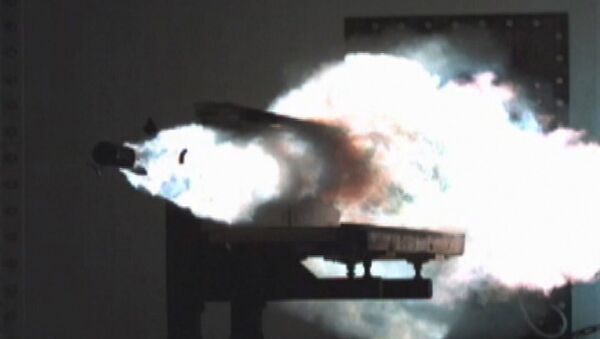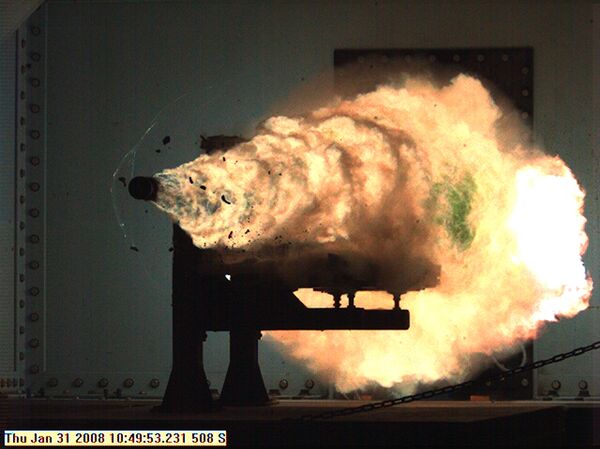In February, the People's Liberation Army-Navy became the first known navy in the world to install an electromagnetic railgun onto an amphibious assault ship. According to a US intelligence report, sections of which were leaked to CNBC last week, China is expected to install the gun onto a destroyer by 2025. This, according to Task and Purpose, would be "a major strategic coup" for Beijing.
Railgun rounds are propelled by electromagnetic pulses instead of gunpowder and thus expected to be both cheaper to operate and more effective than existing cannons. They are also immensely powerful and destructive.
"If the PLA-N's fleets actually include any significant number of railgun-equipped ships by 2025," The War Zone said in an analysis of the American intel assessment, "it is even more likely that the era of near-total United States naval supremacy in any prospective conflict, especially in Pacific Region, will have come to a close."
Previous photos of the railgun appearing on a PLA-N ship showed the weapon mounted on the bow of a Type 072II-class landing ship (NATO designation Yuting-class), which is suited for amphibious assault warfare. Railguns have long been high on the wish lists of navies around the world, including those of Iran, Russia, and the United States, CNBC noted. Russia and the US have both tested their own railguns, but not on ships.
— 下个ID见 (@N3tvsGwZ2pGKEp4) February 1, 2018
"By actually putting the weapon on the ship, China succeeded where the US Navy had failed for over a decade," Business Insider reported June 28.
According to the research arm of the US Navy, the Office of Naval Research, projectiles launched from electromagnetic guns can achieve a velocity of 4,500 miles per hour. The amount of kinetic force created by the armature within the gun, which produces electric current when it turns in a magnetic field, means that the rounds are so powerful they don't need any auxiliary explosives to inflict severe damage upon strike targets.
Looking at a picture of a projectile fired from a railgun, one might assume it contains flammable explosives. In reality, the metal rounds simply cut through air so fast they create incredible friction, hence the fireball.
The force of a projectile launched by a railgun is complemented by the gun's ability to hit targets beyond visual range. China's railgun is capable of making dust out of targets nearly 125 miles out, CNBC noted, which translates to being able to shoot a target in Philadelphia from Washington, DC, in 90 seconds, given the incredible speeds at which the projectile travels.
Since 2005, the US has dropped some $500 million developing the electromagnetic railgun. Developers have tested the weapon on firm ground and gotten it to work, but the US Navy appears to be postponing or abandoning future railgun development. Once seen as a game changer in navy surface warfare scenarios, the railgun may not be seen on a US Navy vessel for quite a while.
The Strategic Capabilities Office within the Pentagon is stifling further progress of the ONR's railgun in favor of alternatives they feel are more cost effective: the hypervelocity projectile, or HVP, and solid-state lasers.
The HVP is similar to the electromagnetic railgun in that projectiles travel very fast, (but not as fast as the railgun-fired projectile) but could be fired from the Mark 45 cannons already aboard surface warships, unlike railgun technology.
"HVP takes the projectile technology from the railgun program and adapts it to fire from existing US Navy 5-inch guns. HVP doesn't get the same speed and distance railguns do — at Mach 3 they travel at about half the speed and at about 30 miles they only travel a third of the range — but they're still a considerable improvement over existing 5-inch shells," Popular Mechanics reported December 5.
In short, the Strategic Capabilities Office determined last December that HVPs will result in "a faster transition" to next generation weaponry than the railgun, a spokesman told Task and Purpose at the time.
"We thought railguns were something we were really going to go after, but it turns out that powder guns firing the same hypervelocity projectiles gets you almost as much as you would get out of the electromagnetic railgun, but it's something we can do much faster," Deputy Secretary of Defense Robert Work told Congress in May 2017.
"The railgun concept has some very tricky problems China may not overcome, but even if China doesn't, completing the project would embarrass the US," Business Insider warned Thursday.






